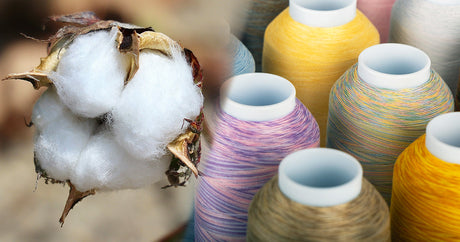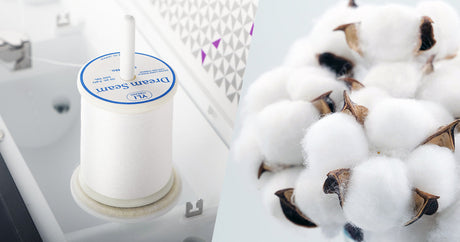Why Egyptian Cotton Thread Matters
When it comes to choosing the best cotton thread for quilting, many quilters are surprised to find themselves wondering about a label they've seen for years: Egyptian cotton. Does it really matter? Is it worth the price? Or is it just another marketing buzzword?
If you enjoy piecing or quilting on a home sewing machine or longarm, and like to use cotton threads, this educational article is for you. Let's unravel the truth behind Egyptian cotton and how it compares to other types of cotton thread for quilting.
Egyptian cotton has built a reputation for luxury, not just in quilting threads, but in sheets, towels, clothing, and all types of woven fabrics. What sets it apart is where and how it grows. Grown and cultivated in the Nile River delta, Egyptian cotton benefits from mineral-rich soil, stable warmth, and optimal irrigation. These growing conditions support the development of extra-long staples, with each fiber being longer, smoother, and stronger than regular cotton.
Especially regarding thread, Egyptian-grown cotton threads result in fewer breaks, less lint, better color retention, and a noticeably smoother finish compared to cotton threads made from other sources.
Is Egypt a Top Cotton Producer?
This is where things get interesting. Egypt is known for its quality, not its quantity. The world's five largest cotton producers include India, China, the U.S., Brazil, and Pakistan. Egypt isn't even in the top 15, and while it is globally renowned, it produces a small fraction of the world's cotton, less than 0.5 percent (not 5 percent, zero-point-five percent). On a world scale, that is a minimal amount.
Despite this, products labeled as "Egyptian cotton" are widely available. How is that possible? Unfortunately, much of it isn't genuine. The Cotton Egypt Association recently reported that up to 85 percent of global Egyptian cotton claims are counterfeit, often blended with inferior fibers or mislabeled entirely.
The USDA Foreign Agricultural Service reports an estimate that more than ten times as much "Egyptian cotton" is sold as is grown, due to mislabeling, dilution, blending with non-Egyptian fibers, or outright dishonesty. From the cotton fields to the textile mill that gins the cotton bolls, to spinning, to twisting, to dying, and to the final winding on the spools, the cotton may change hands five or six times. And it's well known that the gravitas of Egyptian cotton is such that changing the label from regular cotton to Egyptian cotton increases the value of the end product, whether it be bed sheets, towels, linens, clothing, or other items. That's why buying from trusted brands matters.

Dream Seam is our 50 wt. piecing, quilting, and sewing thread made from 100% Egyptian-grown cotton.
How Can You Tell If It's Real Egyptian Cotton?
Short of DNA testing, it's challenging to determine the origin or genetic makeup of cotton thread. Since we don't have tabletop DNA sequencing instruments in every household, we recommend purchasing from trusted brands. At YLI Threads, our cotton threads, including Dream Seam (50 wt.), Majestic (40 wt.), and Hand Quilting Thread, are made from 100% Egyptian-grown, Giza class, extra-long staple cotton. At every stage, from harvest to dyeing to final winding, every step is traceable.
We ship bales of Egyptian-grown cotton to our processing factories in Japan, which are the only facilities in the world that can process (carding, spinning, twisting, gassing, initial winding, secondary winding, mercerizing, dyeing, final winding) to our exacting standards. Just like manufacturing most high-quality products, the process is lengthy, taking approximately six months, from baling the cotton to producing the finished thread.
Why Does Staple Length Matter in Cotton Thread?
Cotton fibers are categorized based on their average length, which significantly influences the quality and durability of the resulting product. The longer the fibers, the fewer fiber ends (hairs and lint), and the smoother, silkier, and stronger the thread. The term "staple" is used to describe an individual fiber within the cotton boll.
- Short Staple: Fibers 0.87 to 1.1 inches (22–28 mm)
- Long Staple: Fibers 1.13 to 1.38 inches (28-35 mm)
- Extra-long Staple: Fibers 1.38 inches to 1.75+ inches (35–45+ mm)
The longer the fiber, the fewer loose ends it has. That means less lint in your machine and a smoother, silkier thread. Extra-long staple cotton threads, such as Dream Seam and Majestic, not only stitch beautifully but also have less breakage and lint. Learn more about cotton staples and their impact on thread quality.
Does Origin Really Matter? Think Idaho Potatoes
To understand why origin matters regarding where the cotton crop is grown, think about Idaho potatoes. You've probably seen restaurants advertise them like they're something special. Does it really matter if a potato is grown in Idaho? Those from Idaho say, "Of course it does." Most people outside Idaho probably don't give it much thought. However, Idaho's unique climate, volcanic soil, and growing conditions give potatoes a texture and taste that chefs and fast food giants alike rely on for consistent results. McDonald's, for example, sources a large share of its French fry potatoes from Idaho for that exact reason, and Idaho potatoes account for a substantial portion of the 9 million pounds of French fries McDonald's serves daily.
It's the same with cotton. Where it's grown affects how it performs. Egyptian-grown cotton benefits from the mineral-rich soil and balanced climate of the Nile delta, producing longer, stronger fibers that make better thread. Just like the Idaho potato earns its place on the menu, Egyptian cotton earns its reputation in your sewing room.

Extra-long staple cotton threads are of the highest quality due to the exceptional length of their fibers.

Majestic, our 40 wt. Egyptian-grown extra-long staple cotton thread is a beautiful thread to use for quilting.
Egyptian Cotton vs. Other Cotton Threads
How does Egyptian-grown extra-long staple thread compare to a regular cotton thread? Here's a quick comparison:
| Feature | Egyptian Cotton | Standard Cotton |
|---|---|---|
| Fiber Length | Extra-long (1.38+ in) | Short to long (under 1.3 in) |
| Strength | High | Medium to low |
| Lint | Very low | High to moderate |
| Smoothness | Silkier surface | Fuzzy surface |
| Color Uniformity | Excellent | High to moderate |
| Price | Higher | Moderate to cheap |
You will pay extra for threads made from Egyptian cotton, but the strength, improvements in stitch quality, consistency, and reduced lint make it a wise choice for quality-focused quilters.
Strength and Durability of Egyptian Cotton Thread
As we touched on earlier in this article, Egyptian extra-long staple cotton is renowned for its exceptional tensile strength, which enables the fibers to resist breakage when quilting and sewing. This increased strength reduces the number of thread breaks, helping to maintain consistent tension and smooth stitches across all types of machines, from home sewing machines to longarm quilting machines. The fibers also have a soft, uniform surface that reduces friction, making them glide effortlessly through tension guides and the eye of a needle.
Another key benefit is absorbency. Egyptian cotton absorbs dye more readily and evenly, producing rich, vibrant colors that are less prone to fading. This trait, known as colorfastness, is especially valued in quilts intended for display or to enjoy a long life of use. Combined with reduced lint and cleaner stitch formation, this makes Egyptian cotton thread not only strong but also beautifully reliable.
Common Myths About Egyptian Cotton Thread
- MYTH: Egyptian cotton is just a marketing gimmick.
- FACT: 100% Egyptian-grown cotton is the gold standard for cotton threads. While it's true that there are more products labeled as "Egyptian cotton" than what is produced, certified Giza class Egyptian cotton is used to make the highest-quality cotton threads.
- MYTH: All cotton threads are the same, regardless of where the cotton comes from.
- FACT: Cotton grown in the Nile Delta develops differently due to the climate and soil conditions. Egyptian-grown extra-long staple cotton produces smoother, stronger threads with improved dye absorption than cotton from other regions.
- MYTH: Egyptian cotton is primarily used for bed sheets and woven textiles because it's too delicate for machine quilting.
- FACT: Egyptian-grown extra-long staple cotton is exceptionally strong and ideal for high-speed quilting, including on longarm machines. Its smoothness and low lint make it an excellent choice for 40 wt. and 50 wt. threads.
About YLI's 40 wt. Majestic Quilting Thread
For machine quilting, our 40 wt. Majestic thread is genuinely exceptional. Made from 100% Egyptian-grown extra-long staple cotton, this thread is available in forty-five variegated colors and five solid colors. Bold and ready to enhance any quilt with eye-catching motifs, filigree, feathers, or edge-to-edge designs. Majestic is one of our premium cotton quilting threads, available in 2,000-yard cones and 600-yard spools.
Get inspired by Majestic colors








